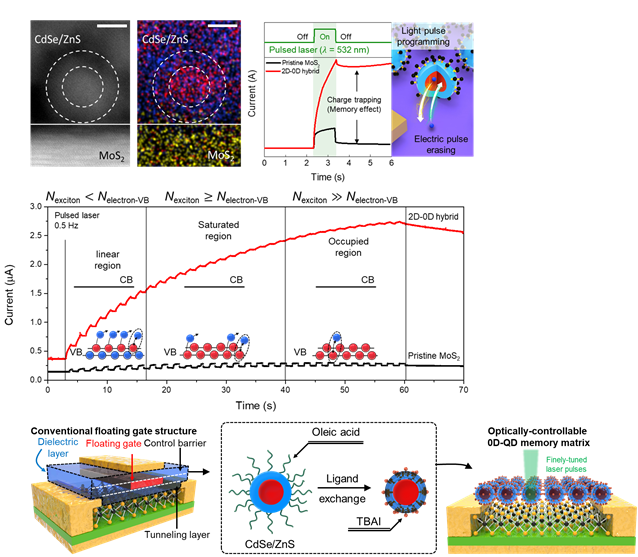The current era is one of data deluge. The data centers that are used to store and analyze this stream of data consume a lot of power, which has been identified as a major source of pollution. Polygonal computing systems with lower power consumption and higher computation speed are being explored to address this dilemma, however, they cannot manage the massive demand for data processing since they function using electrical signals, exactly like conventional binary computing systems.
 Electron micrographs of the 2D-0D hybrid surface implemented in this study (top left), memory characteristics generated by light pulses (top right), and polynomial memory characteristics generated by multiple light pulses (bottom). Image Credit: Korea Institute of Science and Technology
Electron micrographs of the 2D-0D hybrid surface implemented in this study (top left), memory characteristics generated by light pulses (top right), and polynomial memory characteristics generated by multiple light pulses (bottom). Image Credit: Korea Institute of Science and Technology
Dr. Do Kyung Hwang of the Center for Opto-Electronic Materials & Devices and Professor Jong-Soo Lee of the Department of Energy Science & Engineering at Daegu Gyeongbuk Institute of Science and Technology collaborated on a new zero-dimensional and two-dimensional (2D-0D) semiconductor artificial junction material and discovered the impact of a next-generation memory powered by light, according to the Korea Institute of Science and Technology.
Using light instead of electrical signals to transfer data between computational and storage components of a multi-level computer can significantly boost processing speed.
The scientists created a novel 2D-0D semiconductor artificial junction material by connecting quantum dots in a core-shell configuration with zinc sulfide (ZnS) on the surface of cadmium selenide (CdSe) and molybdenum sulfide (MoS2). The novel material allows storing and manipulating electronic states inside quantum dots as small as 10 nm.
A certain number of electrons exit the molybdenum sulfide semiconductor when light is applied to the cadmium selenide core, trapping holes in the core and making it conductible. Cadmium selenide also quantizes the electron state.
Through the field effect, intermittent light pulses trap electrons in the electron band one after another, changing the resistance of the molybdenum sulfide. Depending on the number of light pulses, the resistance varies in a cascade fashion.
Contrary to conventional memory, which only contains 0 and 1 states, this technique enables the division and maintenance of more than 0 and 10 states. Each quantum dot can act as a memory since the zinc sulfide shell stops charge leakage between nearby quantum dots.
The team's quantum dot structure completely duplicates the floating gate memory structure, which confirms its potential for application as a next-generation optical memory, in contrast to quantum dots in typical 2D-0D semiconductor artificial junction designs, which merely amplify signals from light sensors.
The CIFAR-10 dataset was used by the researchers to test the polynomial memory phenomena, and they were successful in achieving a 91% recognition rate.
The new multi-level optical memory device will contribute to accelerating the industrialization of next-generation system technologies such as artificial intelligence systems, which have been difficult to commercialize due to technical limitations arising from the miniaturization and integration of existing silicon semiconductor devices.
Dr. Do Kyung Hwang, Principal Research Scientist, Korea Institute of Science and Technology
The Ministry of Science and ICT (Minister Jong-ho Lee) funded this research as a major project for KIST and a mid-career researcher project. The findings were published in the international journal Advanced Materials.
Journal Reference:
Ra, H.-S., et al. (2023) Probing Optical Multi-Level Memory Effects in Single Core-Shell Quantum Dots and Application Through 2D–0D Hybrid Inverters. Advanced Materials. doi:10.1002/adma.202303664